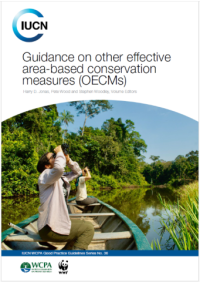Position paper
üСÜꪤüýò¢ˆ§Ý§Ã¿«üø°ÀøÝýË Position Paper for OEWG-3
The third meeting of the Open-Ended Working Group considered the first draft of the Post-2020 Global Biodiversity Framework. In this paper, üСÜꪤüýò¢ˆ§Ý§Ã¿«üø°ÀøÝýËô outlines detailed views.
In summary, üСÜꪤüýò¢ˆ§Ý§Ã¿«üø°ÀøÝýË calls for:ô
- Distinct goals for the components of biodiversity: ecosystems, species and genetic diversity
- Protection of 30% globally of terrestrial, freshwater and marine ecosystems, in equitably governed and effectively managed and connected systems of protected areas and other effective area-based conservation measures, including all key biodiversity areas.
- Use of the üСÜꪤüýò¢ˆ§Ý§Ã¿«üø°ÀøÝýË Green List of Protected and Conserved Areas Standard to ensure that new and existing protected areas are effective in achieving their biodiversity and social outcomes, fully respecting the rights, custodianship and participation of Indigenous Peoples and Local Communities.
- Scaling up of species conservation through an ambitious species goal for 2050, and specific targets that prevent extinctions, improve the status of wild species and ensure that use is safe, legal and sustainable.
- Recognition of the need for a Global Species Action Plan to support action for species.
- Restoration of degraded ecosystems globally, through an ambitious goal on ecosystems for 2050, and targets for resurrecting the integrity of natural ecosystems (including connectivity) and sustainability of managed ecosystems through the UN Decade on Ecosystem Restoration.
- The allocation of USD 600 - 800 billion per annum (approximately 0.7-1% of global GDP) to fund implementation of the post-2020 framework, noting that current funding is less than USD 200 million:
- Increased investment in nature (from all sources) to at least USD 200 billion per year, increasing by at least USD 66 billion per year through international financial flows to developing countries and increased domestic resource mobilization.
- Integration of nature into economic policies across government departments through eliminating, redirecting and reducing subsidies harmful to nature by at least USD 500 billion per year.
- Strengthening the ãline of sightã across the whole framework is needed; each national target must connect to (ãadd up toã) the global targets to make the national level contribution to the global target transparent and accountable.
- Strengthening the link between the Framework and national planning processes, by having Parties immediately update the existing NBSAPs in accordance with the approved new goals and targets. In the formulation and communication of every new NBSAP, Parties should state explicitly how the goals and targets of the Framework have been taken into account and how the national targets will connect to the respective global target.
- Scaling up monitoring efforts to assess whether national targets will yield the intent of the global target(s): the only way it will be possible to measure progress in the next 30 years.
- Establishing regular 'global biodiversity stocktakes' to enable countries to periodically determine and then enhance, as necessary, ambition, resource mobilization and implementation efforts.
- Integration of a rights-based approach (RBA) more consistently and comprehensively across the Framework. This requires integrating rights issues at relevant points within the language of goals, milestones and targets to ensure cross-cutting integration and to guide effective implementation of a RBA.
- Integration of views and actions from Indigenous Peoples and local communities' in NBSAPs
CONTACT:
Email
SOCIAL:



